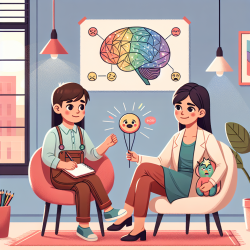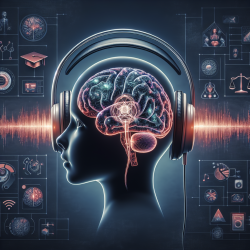Introduction
In the realm of speech language pathology, understanding the mechanisms behind children's language acquisition is crucial. A recent study titled "Children show right-lateralized effects of spoken word-form learning" sheds light on the neurocognitive processes involved in phonological learning in children. This research provides valuable insights for practitioners aiming to enhance their therapeutic strategies.
The Study: A Brief Overview
Conducted by Nora et al., the study explored how 6-8-year-old Finnish-speaking children learn new word forms using magnetoencephalography (MEG). The research focused on comparing native Finnish pseudowords with foreign Korean words to determine the cortical learning effects and their dependence on language proficiency.
Key Findings and Implications
The study found that children's learning of new word forms, whether native or foreign, is predominantly right-lateralized. This contrasts with the left-hemispheric dominance observed in adults. Here are some critical takeaways for practitioners:
- Right-Hemispheric Activation: Children's reliance on the right hemisphere suggests a focus on supra-segmental contours and prosody rather than detailed phoneme-level processing. This indicates that therapy should incorporate activities that enhance prosodic features and melodic patterns.
- Incidental Learning: Children demonstrated improved repetition accuracy for recurring word forms, highlighting the importance of repeated exposure in therapy sessions. Practitioners should design activities that allow for repeated practice of target words in engaging contexts.
- Language Proficiency and Brain Activation: The reduction in right superior temporal cortex activation for recurring word forms suggests that as children become more familiar with word forms, their brain's processing efficiency improves. This underscores the need for tailored interventions that gradually increase in complexity as proficiency develops.
Practical Applications for Speech Language Pathologists
Given these findings, practitioners can enhance their therapeutic approaches by:
- Incorporating Music and Rhythm: Since children rely on prosody, integrating musical elements can facilitate phonological learning. Use songs, rhymes, and rhythmic activities to reinforce language concepts.
- Utilizing Repetitive and Engaging Exercises: Design exercises that allow for repeated exposure to target words, ensuring they are varied and contextually meaningful to maintain engagement.
- Monitoring Progress and Adjusting Strategies: Regularly assess children's progress and adjust the complexity of tasks based on their proficiency, ensuring a balance between challenge and skill level.
Encouraging Further Research
While this study provides a foundation for understanding children's phonological learning, further research is needed to explore the long-term effects of right-lateralized learning and its implications for language acquisition. Practitioners are encouraged to stay informed about ongoing research and incorporate evidence-based practices into their therapy sessions.
To read the original research paper, please follow this link: Children show right-lateralized effects of spoken word-form learning.










